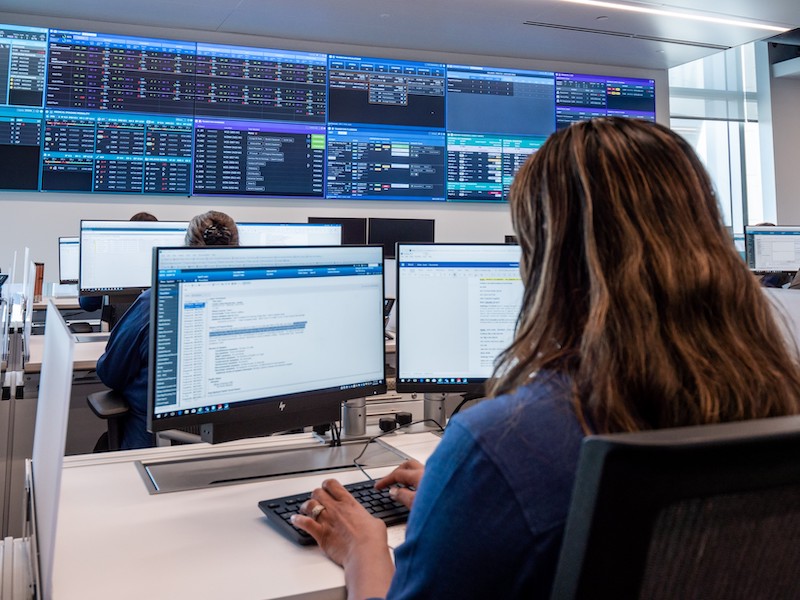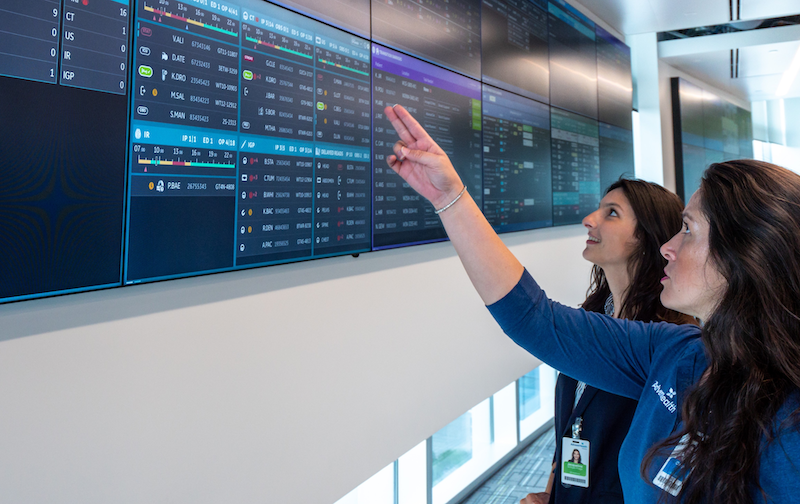Technology is going to transform how medicine works, from building resiliency to cope with crises or natural disasters to improving operational efficiency and the delivery of care to individuals.
By Peter Arduini, CEO of GE HealthCare
One of the biggest challenges facing healthcare today is how to enable the best care for patients while addressing a growing problem: burnout among doctors, nurses and other clinicians. Providers know they can improve the patient experience and tailor medicine more and more to the individual seeking treatment. But they face numerous hurdles, including reducing costs and making healthcare more efficient so that patients can get treatment when and where they want it, and those caring for them can focus on supporting their journey.
The key is data and how it’s leveraged. Connecting data from medical devices, clinical settings and patients can unblock bottlenecks, help diagnose cancer faster and even predict how an individual will respond to a particular treatment. This is in addition to improving the satisfaction of the doctors and nurses, creating efficiencies and giving them back time to focus on patient care. Unlocking the promise of precision medicine relies on integrating the growing amount of patient data in smart ways and using the latest technologies to make sense of it. GE HealthCare, working with our partners, is making that future real right now.
How Real-Time Healthcare Can Expand Treatment and Reduce Burnout
AdventHealth is a nonprofit healthcare system operating in nine U.S. states, and it had a key advantage when COVID struck. In the years leading up to the pandemic, AdventHealth underwent a digital transformation, linking eight acute-care sites to a central “mission control” using GE HealthCare’s Command Center. Networking AdventHealth’s system allowed managers to see where and when beds and equipment were available in real time so they could balance utilization across those sites and cut down on thankless, time-consuming coordination tasks. As a result, AdventHealth created the equivalent of 34 beds of patient capacity at one facility, a 3.4% increase in adult beds, and increased the rate at which it accepted transfers by 800 patients a month, all with software.
Image courtesy of AdventHealth
At the time, no one there expected COVID — it was simply a smart move to upgrade technology. Of course, it ended up creating tremendous resilience so that AdventHealth could better cope with the pandemic as well as natural disasters. “What we were able to do in real time is understand where our beds were and what our true capacity was,” says Dr. Sanjay Pattani, the system’s associate chief medical officer.
Building the capacity to cope with the unexpected and to care for more patients with the same resources will become essential to more and more healthcare providers if current trends continue. Nearly four in ten clinicians who plan to change roles in the next few years say they will retire or leave healthcare.[1] Burnout is a major cause, exacerbated by the long hours, repetitive processes and the tremendous emotional toll of caring for the sick during the pandemic. For example, the proportion of doctors who reported at least one sign of burnout jumped to 63% in 2021 from 38% in 2020 in a U.S survey.[2]
If healthcare’s most precious resource — clinicians — is shrinking, another is growing: raw data. Harnessing this data is the key to overcoming many of healthcare’s biggest challenges today, including burnout, but 97% of it currently goes unused.[3]
AdventHealth and other hospital systems like it know that once you harness your data and turn it into information that is easy for staff to use in their daily processes, the opportunities are endless. Connecting care sites and systems to form a real-time healthcare solution makes it easier to coordinate care to meet discharge targets, for example, or to better plan surgery schedules, resolve bottlenecks that cause patients to wait, and make sure the sickest patients are getting the attention they need. In other words, it makes the care journey more efficient, improves outcomes and manages costs. And, importantly, it increases both patient and staff satisfaction. Suddenly staff spend less time on the things we know cause burnout — like digging for information, reworking decisions made with incomplete information and duplicating tasks — and more time on patient care. And the data is even used to help them see around corners.
Image courtesy of AdventHealth
Precise Care Starts with Data
Using data is also key to precision care. By integrating artificial intelligence (AI) at the right time and in the right way, the future of healthcare is more precise, with a faster, accurate diagnosis and targeted treatment plan. Precision medicine puts the patient at the center of treatment, taking into consideration their background, lifestyle and genetics to define the most appropriate treatment or combinations of treatments available.
GE HealthCare has already put AI to work optimising the images from diagnostic devices like MRI and CT. What we’re unlocking next is the story behind those images, by combining them with the patient’s genetic profile, clinical data such as a biopsy or pathology, and biologic or hemodynamic data. Instead of looking only at a CT scan, for example, to make a diagnosis the radiologist of the future may instead see a report generated from the CT machine with findings ranked by probability along with suggested therapies and likely outcomes.
We are building the Edison Digital Health Platform to enable this vision to integrate and orchestrate imaging, patient data, pathology and genomic information. The goal is to provide the tools to support decision-making for targeting immune, chemo and genomic-linked therapies. We are in the initial phase of testing of our digital health platform in the IT environment of various care facilities in the USA, Europe and Asia. We are building a comprehensive collaboration ecosystem in radiation oncology and designing a digital health platform — innovations that enable interoperability of radiation therapy solutions. And we’re involved in a research-and-development collaboration on multimodal predictive analytics and molecular and radiomic imaging solutions that will move patient care from being able to diagnose disease to offering a prognosis and even predicting response to therapy.
A series of collaborations we announced last year provide great examples of how connected healthcare can make precision treatment more accessible. Working with SOPHiA GENETICS, the University of Cambridge and Optellum, we’re working to deploy our Edison Digital Health Platform to integrate data from patients undergoing cancer treatment. The sources of this data are diverse, including radiology and electronic health records, and span the patient journey from initial screening to treatment and follow-up monitoring. The need is huge: The rate of new cancer cases worldwide is expected to reach 29 million by 2040.[4] By linking this patient data together and making it more accessible, our goal is that clinicians and researchers will be able to use the Edison Digital Health Platform to develop and deploy AI to simplify the patient’s experience getting oncology treatment, better understand increasingly complicated clinical patient data, and compare data from patient to patient.
Making it easy to create value from the many episodes of data captured about a patient over time is the last key piece moving healthcare into the future and improving the patient experience by making care a continuous journey. Anyone who's ever had their blood pressure measured in the doctor's office has thought about the fact that the reading would likely have been different had it been taken an hour earlier, when they were relaxed at home. As these virtual connections between medical devices, doctors, patients and hospitals proliferate, it will change how healthcare captures patient data from the hospital to the home. Instead of a snapshot once or twice a year, doctors will be able to see the movie version, which shows how patients are doing over time and in detail.
Our recently announced collaboration with AliveCor, which makes at-home ECG devices, is a great example. By integrating the readouts from AliveCor’s products into our MUSE ECG database, and ultimately our Edison platform, a cardiologist sees the information that the patient is generating on their own in addition to information from traditional ECG devices in the clinical setting. That makes the doctor’s decision-making more precise, leading to better outcomes even as it reduces the burden on clinicians to do this kind of data collection.
KardiaMobile® 6L from AliveCor is the first FDA-cleared, AI-enabled consumer ECG platform for the efficient detection of atrial fibrillation and other heart rhythm conditions.
Today, healthcare around the world is responding to unprecedented challenges with smarter thinking and a more connected, tailored approach to care. Harnessing the tremendous potential of data is the promised land — it’s where we’re going and the only way we can improve patient care sustainably and at scale.
REFERENCES
[1] Elsevier, “Clinician of the Future: a 2022 Report,” March 15, 2022.
[2] Tait D. Shanafelt et al., “Changes in Burnout and Satisfaction with Work-Life Integration in Physicians Over the First 2 Years of the COVID-19 Pandemic,” Mayo Clinic Proceedings, September 13, 2022, DOI:https://doi.org/10.1016/j.mayocp.2022.09.002.
[3] World Economic Forum, “4 Ways Data Is Improving Healthcare,” December 5, 2019, https://www.weforum.org/agenda/2019/12/four-ways-data-is-improving-healthcare.
[4] J. Ferlay et al., “Cancer Tomorrow,” 2022, International Agency for Cancer Research, World Health Organization, https://gco.iarc.fr/tomorrow.




